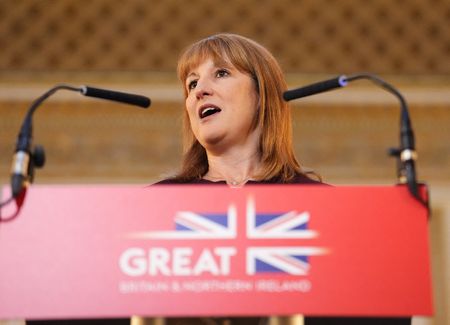By William Schomberg
LONDON (Reuters) – Britain’s borrowing has shot past the official forecasts that underpin the government’s tax and spending plans, compounding the already big challenge facing finance minister Rachel Reeves in her November budget.
Public sector borrowing totalled 83.8 billion pounds ($113.39 billion) between April and August, 11.4 billion pounds more than projected by Britain’s fiscal watchdog, official data published on Friday showed.
The borrowing was the highest for the first five months of a financial year since 2020 when the coronavirus pandemic forced the government into huge spending to prop up the economy.
Even before Friday’s figures, Reeves had been expected to announce new tax increases in her November 26 budget to stay on track to meet her fiscal rules and avoid fresh upheaval in financial markets.
Higher taxes are likely to slow Britain’s already stumbling economic growth, which Reeves and Prime Minister Keir Starmer have promised they will speed up.
STERLING FALLS ON NEWS
Nabil Taleb, a PwC UK economist, said the government faced a combination of higher debt costs, hot inflation, opposition to spending cuts and the risk of an OBR downgrade to its growth forecasts, which would make Reeves’ rules harder to meet.
“The chancellor faces tough choices, and the test will be whether she can make them palatable to voters and markets,” Taleb said.
Sterling fell by half a cent against the U.S. dollar and government borrowing costs rose after the borrowing figures were released along with separate data that showed a stronger-than-expected increase in retail sales volumes in August.
In August alone, the government borrowed almost 18 billion pounds, much higher than the estimate of a 12.5 billion-pound overshoot predicted by the Office for Budget Responsibility and above all forecasts in a Reuters poll of economists.
“Although overall tax and National Insurance receipts were noticeably up on last year, these increases were outstripped by higher spending on public services, benefits and debt interest,” Grant Fitzner, chief economist at the Office for National Statistics, said.
The ONS revised up its estimates for borrowing in recent months by almost 6 billion pounds after tax office data showed value-added tax receipts were lower than initially thought.
Updated figures from local and devolved administrations also contributed to the worsening of the deficit.
Prior to Friday’s data release, public sector borrowing had been tracking close to the OBR’s forecasts.
Paul Dales, chief UK economist at Capital Economics, said Reeves would probably have to announce fiscal measures, mostly tax increases, worth 28 billion pounds in her budget, approaching the 40 billion pounds of tax hikes in her first budget last year and which she has vowed not to repeat.
Earlier on Friday, the Institute for Fiscal Studies think tank said Reeves risked “a major fiscal issue” if she misses her ambitious plans to make public services more efficient, highlighting another risk to her ability to meet her targets.
Reeves has said she will balance day-to-day public spending with tax revenues by the end of the decade.
Friday’s data showed that measure of the public finances was in deficit by 62 billion pounds in the April-August period, more than 15 billion pounds above the OBR’s estimate.
Reeves and Starmer promised voters before last year’s election they would not raise rates of income and value-added tax or social security contributions paid by employees.
Employers have expressed concern that they might again bear the brunt of tax hikes in November, having been hit with higher social security bills in Reeves’ first budget last year.
James Murray, a deputy finance minister, said the government’s focus was on economic stability, fiscal responsibility and speeding up growth.
(Writing by William Schomberg; Editing by William James, Sarah Young, Peter Graff)











